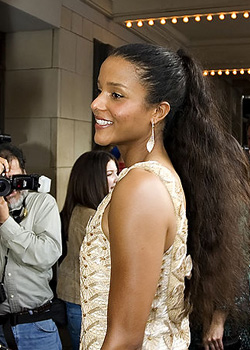Source(google.com.pk)
Tall Hollywood
Actresses Biography
Date of Birth
29 August 1915, Stockholm, Sweden
Date of Death
29 August 1982, Chelsea, London, England, UK (lymphoma complications following a breast cancer operation)
Height
5' 9" (1.75 m)
Mini Biography
Ingrid Bergman was born in Stockholm, Sweden, on August 29, 1915. The woman who would be one of the top stars in Hollywood in the 1940s had decided to become an actress after finishing her formal schooling. She had had a taste of acting at age 17 when she played an uncredited role of a girl standing in line in the Swedish film Landskamp (1932) in 1932 - not much of a beginning for a girl who would be known as "Sweden's illustrious gift to Hollywood." Her parents died when she was just a girl and the uncle she lived with didn't want to stand in the way of Ingrid's dream. The next year she enrolled in the Swedish Royal Theatre but decided that stage acting was not for her. It would be three more years before she would have another chance at a film. When she did, it was more than just a bit part. The film in question was Munkbrogreven (1935), where she had a speaking part as Elsa Edlund. After several films that year that established her as a class actress, Ingrid appeared in Intermezzo (1936/I) as Anita Hoffman. Luckily for her, American producer David O. Selznick saw it and sent a representative from Selznick International Pictures to gain rights to the story and have Ingrid signed to a contract. Once signed, she came to California and starred in United Artists' 1939 remake of her 1936 film, Intermezzo: A Love Story (1939), reprising her original role. The film was a hit and so was Ingrid. Her beauty was unlike anything the movie industry had seen before and her acting was superb. Hollywood was about to find out that they had the most versatile actress the industry had ever seen. Here was a woman who truly cared about the craft she represented. The public fell in love with her. Ingrid was under contract to go back to Sweden to film Only One Night (1939) in 1939 and Juninatten (1940) in 1940. Back in the US she appeared in three films, all well-received. She made only one film in 1942, but it was the classic Casablanca (1942) opposite the great Humphrey Bogart.
Ingrid was choosing her roles well. In 1943 she was nominated for an Academy Award for her role in For Whom the Bell Tolls (1943), the only film she made that year. The critics and public didn't forget her when she made Gaslight (1944) the following year--her role of Paula Alquist got her the Oscar for Best Actress. In 1945 Ingrid played in Spellbound (1945), Saratoga Trunk (1945) and The Bells of St. Mary's (1945), for which she received her third Oscar nomination for her role of Sister Benedict. She made no films in 1947, but bounced back with a fourth nomination for Joan of Arc (1948). In 1949 she went to Italy to film Stromboli (1950), directed by Roberto Rossellini. She fell in love with him and left her husband, Dr. Peter Lindstrom, and daughter, Pia Lindström. America's "moral guardians" in the press and the pulpits were outraged. She was pregnant and decided to remain in Italy, where her son was born. In 1952 Ingrid had twins, Isotta and Isabella Rossellini, who became an outstanding actress in her own right, as did Pia. Ingrid continued to make films in Italy and finally returned to Hollywood in 1956 in the title role in Anastasia (1956), which was filmed in England. For this she won her second Academy Award. She had scarcely missed a beat. Ingrid continued to bounce between Europe and the US making movies, and fine ones at that. A film with Ingrid Bergman was sure to be a quality production. In her final big-screen performance in 1978's Autumn Sonata (1978) she had her final Academy Award nomination. Though she didn't win, many felt it was the most sterling performance of her career. Ingrid retired, but not before she gave an outstanding performance in the mini-series A Woman Called Golda (1982) (TV), a film about Israeli prime minister Golda Meir. For this she won an Emmy Award as Best Actress, but, unfortunately, she didn't live to see the fruits of her labor. Ingrid died from cancer on August 29, 1982, her 67th birthday, in London, England.
IMDb Mini Biography By: Denny Jackson
Mini Biography
Born in Stockholm, Sweden, on August 29, 1915 - Ingrid Bergman was one of the greatest actresses from Hollywood's lamented Golden Era. Her natural and unpretentious beauty and her immense acting talent made her one of the most celebrated figures in the history of American cinema. Bergman is also one of the most Oscar-awarded actresses, second only to Katharine Hepburn.
Before she came to Hollywood in 1939, she was already an established actress in Sweden. She had completed 11 Swedish films when producer David O. Selznick invited her to come to Hollywood to reprise her role in the American version of her biggest hit, Intermezzo: A Love Story (1939) opposite Leslie Howard. Her performance in her American debut captured America's heart. She later appeared in Adam Had Four Sons (1941), Rage in Heaven (1941) and Dr. Jekyll and Mr. Hyde (1941). However, it was Casablanca (1942) that launched her to superstardom, establishing her as a romantic leading lady. The pairing with Humphrey Bogart made them one of the best romantic cinema couples of all time and the film still vows audiences, more than 60 years after its release. In 2002 the American Film Institute named Casablanca (1942) as the top American love story of all time, beating such favorites as Gone with the Wind (1939) and West Side Story (1961). Ironically enough, both Bogart and Bergman tried to quit the film during shooting, feeling that the story was ridiculous and unbelievable. Bergman herself said at the time that she hoped it would never be shown again after she died.
After Casablanca (1942), she became Hollywood's top box-office draw. All of her films became smash hits; she starred opposite Gary Cooper in Ernest Hemingway's For Whom the Bell Tolls (1943), which she cited as her personal favorite film. She also gave an Oscar-winning performance as the persecuted wife of Charles Boyer in George Cukor's Gaslight (1944) and Leo McCarey's very popular The Bells of St. Mary's (1945). Later, she worked with the master himself, Alfred Hitchcockin Spellbound (1945), Notorious (1946) with Cary Grant and the less successful Under Capricorn (1949).
Bergman suffered a sudden and disastrous fall from grace after her affair with Italian director Roberto Rossellini, which began when she filmed Stromboli (1950) with him, and caused a scandal in the US because she was married at the time. After being exiled from Hollywood for seven years, she came back with Anastasia (1956), which garnered her a second Academy Award. After all the years she spent away from Hollywood, she still managed to maintain her status as a major star, as the success of films like Indiscreet (1958) and The Inn of the Sixth Happiness (1958) showed. In the 1960s she concentrated in stage work and television appearances, collaborated with her third husband Lars Schmidt, who was also a theatrical producer, in such plays as The Turn of The Screw (1960) and Twenty-Four Hours in a Woman's Life (1961). She didn't appear in as many films after the 1960s as she had before, but she continued to win awards and accolades from the film industry. One of her last performances was in Murder on the Orient Express (1974), for which she won her final Academy Award. Later she worked in Ingmar Bergman's Autumn Sonata (1978) and a TV mini-series, A Woman Called Golda (1982) (TV). In these two pieces Bergman gave the performances of her lifetime, a fitting end to an extraordinary career and life. She died in her sleep at the end of her 67th birthday, 29th of August 1982.
Ingrid Bergman will always be remembered as Bogart's lost love Ilsa Lund in Casablanca (1942). It's sad because she also gave spectacular performances as Maria in For Whom the Bell Tolls (1943), Paula Alquist in Gaslight (1944), Dr. Constance Peterson in Spellbound (1945), Alicia Huberman in Notorious (1946), the title role in Anastasia (1956), Gladys Aylward in The Inn of the Sixth Happiness (1958) and Charlotte in Autumn Sonata (1978). She worked in films, television and on the stage in New York, London, Paris, Rome and Stockholm. She worked right up to her death. In 1999 she was ranked #4 in the American Film Institute's list of greatest female screen legends. As Humphrey Bogart said, "Here's looking at you kid", and until this day, we are still looking at you, Ingrid!
IMDb Mini Biography By: naim81@bluehyppo.com
Mini Biography
Born in Stockholm, Sweden, on August 29, 1915. Her mother died when she was only two and her father died when she was 12. She went to live with an elderly uncle. At 18, after school graduation, the lonely and shy girl decided to become an actress. In 1934 she debuted in the Swedish film Munkbrogreven (1935). She soon rose to stardom and by 1936 was Sweden's leading film star and got first offers from Hollywood. In 1937 she married Dr. Peter Lindstrom, and in 1938 she gave birth to a daughter, Friedel Pia (aka Pia Lindström). In May 1939 she arrived in New York to do a remake of Intermezzo: A Love Story (1939). The beginning of WWII in Europe persuaded her and her family to return to America in 1940. In 1942 Casablanca (1942) premiered and made her a star of the first rank. Her acting in her next film, For Whom the Bell Tolls (1943), won her an Academy Award nomination. In late 1943 she began working on Gaslight (1944), which won her the 1944 Academy Award. she followed that film with such classics as Alfred Hitchcock's Spellbound (1945) with Gregory Peck and Notorious (1946) with Cary Grant. She returned to Europe after the scandalous publicity surrounding her affair with Italian director Roberto Rossellini during the filming of Stromboli (1950). In the same month the film was released she gave birth to a boy, Robertino. A week after her son was born she divorced Dr. Lindstrom and married Rossellini in Mexico. In June of 1952 she gave birth to the twin daughters Isotta and Isabella Rossellini. From 1951 to 1955 she and her husband did a series of films that were ahead of their time but were generally not received well, especially in the US, where many conservative political and religious leaders still raised a hue and cry about her past. Tired and convinced that she would never make a successful film with Rosselini, she returned to Hollywood and triumphed in Anastasia (1956), for which she received another Oscar. In 1957 she divorced Rosselini and the next year she married Lars Schmidt, a theatrical entrepreneur from a wealthy Swedish shipping family. She received a third Oscar for her role in Murder on the Orient Express (1974). By 1975 she was divorced again. In 1978 she starred in Ingmar Bergman's Autumn Sonata (1978), probably her best film from an artistic standpoint. In the late 1970s she first discovered the symptoms of cancer and underwent a mastectomy. Her last role was in the television film A Woman Called Golda (1982) (TV). For it she won (posthumously) US television's Emmy Award as outstanding actress in a mini-series. She died in London on August 30, 1982, the day after having a small birthday party with a few friends.
Tall Hollywood Actresses











No comments:
Post a Comment